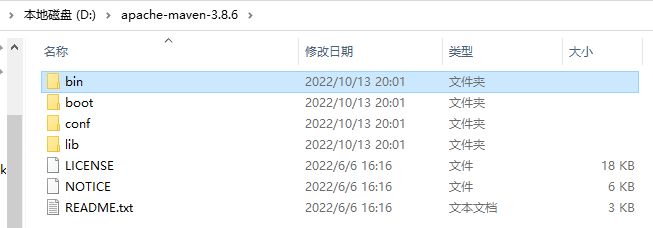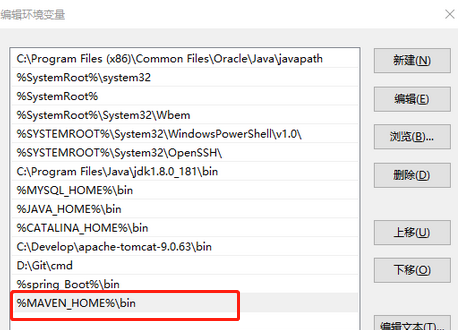maven下载、安装,创建
1,maven准备:
- 需要安装JDK并配置好环境变量
-
下载地址:https://maven.apache.org/download.cgi

2,下载完成之后解压到当前文件夹:D:\apache-maven-3.8.6

3,配置Maven环境变量
- 在我的电脑-------属性-------高级系统设置---------环境变量---------系统变量--------新建
- 新建环境变量MAVEN_HOME 赋值 D:\apache-maven-3.8.6

4. 编辑环境变量Path,追加%MAVEN_HOME%\bin\

5,maven已经完成了安装
- win+r启动DOS命令输入
- cmd-回车---输入“mvn -v”
- 出现以下界面版本号地址等等表示安装成功:

6,修改maven配置文件conf
- 1,maven下载的文件默认放到本地仓库:默认仓库(本机仓库):C:\Users\(登录操作系统的用户名)Administrator.m2\repository
- 2,设置指定的位置存储,需要修改maven配置文件:
conf / settings.xml文件

- 找到标签 <localRepository></localRepository> 从注释拷贝出来,添加自己指定的存储路径
- 指定目录(不要使用中文目录)D:\work\maven_work\maven_repository
- 注意:将路径的反斜线:\,修改为斜线:/
<!-- 修改maven存储到指定的位置--><localRepository>/path/to/local/repo</localRepository> <localRepository>D:/work/maven/maven-repository</localRepository>
7,修改maven默认的JDK版本(xml文件中默认jdk版本为1.4)
-
在<profiles>标签下添加一个<profile>标签,修改maven默认的JDK版本。
<profile> <id>jdk-1.8</id> <activation> <activeByDefault>true</activeByDefault> <jdk>1.8</jdk> </activation> <properties> <maven.compiler.source>1.8</maven.compiler.source> <maven.compiler.target>1.8</maven.compiler.target> <maven.compiler.compilerVersion>1.8</maven.compiler.compilerVersion> </properties> </profile>
8,添加国内镜像源
添加<mirrors>标签下<mirror>,添加国内镜像源,这样下载jar包速度很快。一般使用阿里云镜像库即可。
<!-- 阿里云仓库 --> <mirror> <id>alimaven</id> <mirrorOf>central</mirrorOf> <name>aliyun maven</name> <url>http://maven.aliyun.com/nexus/content/repositories/central/</url> </mirror>
9,附件:完整settings.xml
1 <?xml version="1.0" encoding="UTF-8"?>
2
3 <!--
4 Licensed to the Apache Software Foundation (ASF) under one
5 or more contributor license agreements. See the NOTICE file
6 distributed with this work for additional information
7 regarding copyright ownership. The ASF licenses this file
8 to you under the Apache License, Version 2.0 (the
9 "License"); you may not use this file except in compliance
10 with the License. You may obtain a copy of the License at
11
12 http://www.apache.org/licenses/LICENSE-2.0
13
14 Unless required by applicable law or agreed to in writing,
15 software distributed under the License is distributed on an
16 "AS IS" BASIS, WITHOUT WARRANTIES OR CONDITIONS OF ANY
17 KIND, either express or implied. See the License for the
18 specific language governing permissions and limitations
19 under the License.
20 -->
21
22 <!--
23 | This is the configuration file for Maven. It can be specified at two levels:
24 |
25 | 1. User Level. This settings.xml file provides configuration for a single user,
26 | and is normally provided in ${user.home}/.m2/settings.xml.
27 |
28 | NOTE: This location can be overridden with the CLI option:
29 |
30 | -s /path/to/user/settings.xml
31 |
32 | 2. Global Level. This settings.xml file provides configuration for all Maven
33 | users on a machine (assuming they're all using the same Maven
34 | installation). It's normally provided in
35 | ${maven.conf}/settings.xml.
36 |
37 | NOTE: This location can be overridden with the CLI option:
38 |
39 | -gs /path/to/global/settings.xml
40 |
41 | The sections in this sample file are intended to give you a running start at
42 | getting the most out of your Maven installation. Where appropriate, the default
43 | values (values used when the setting is not specified) are provided.
44 |
45 |-->
46 <settings xmlns="http://maven.apache.org/SETTINGS/1.0.0"
47 xmlns:xsi="http://www.w3.org/2001/XMLSchema-instance"
48 xsi:schemaLocation="http://maven.apache.org/SETTINGS/1.0.0 http://maven.apache.org/xsd/settings-1.0.0.xsd">
49 <!-- localRepository
50 | The path to the local repository maven will use to store artifacts.
51 |
52 | Default: ${user.home}/.m2/repository
53 <localRepository>/path/to/local/repo</localRepository>
54 -->
55 <localRepository>D:\tools\repository</localRepository>
56 <!-- interactiveMode
57 | This will determine whether maven prompts you when it needs input. If set to false,
58 | maven will use a sensible default value, perhaps based on some other setting, for
59 | the parameter in question.
60 |
61 | Default: true
62 <interactiveMode>true</interactiveMode>
63 -->
64
65 <!-- offline
66 | Determines whether maven should attempt to connect to the network when executing a build.
67 | This will have an effect on artifact downloads, artifact deployment, and others.
68 |
69 | Default: false
70 <offline>false</offline>
71 -->
72
73 <!-- pluginGroups
74 | This is a list of additional group identifiers that will be searched when resolving plugins by their prefix, i.e.
75 | when invoking a command line like "mvn prefix:goal". Maven will automatically add the group identifiers
76 | "org.apache.maven.plugins" and "org.codehaus.mojo" if these are not already contained in the list.
77 |-->
78 <pluginGroups>
79 <!-- pluginGroup
80 | Specifies a further group identifier to use for plugin lookup.
81 <pluginGroup>com.your.plugins</pluginGroup>
82 -->
83 </pluginGroups>
84
85 <!-- proxies
86 | This is a list of proxies which can be used on this machine to connect to the network.
87 | Unless otherwise specified (by system property or command-line switch), the first proxy
88 | specification in this list marked as active will be used.
89 |-->
90 <proxies>
91 <!-- proxy
92 | Specification for one proxy, to be used in connecting to the network.
93 |
94 <proxy>
95 <id>optional</id>
96 <active>true</active>
97 <protocol>http</protocol>
98 <username>proxyuser</username>
99 <password>proxypass</password>
100 <host>proxy.host.net</host>
101 <port>80</port>
102 <nonProxyHosts>local.net|some.host.com</nonProxyHosts>
103 </proxy>
104 -->
105 </proxies>
106
107 <!-- servers
108 | This is a list of authentication profiles, keyed by the server-id used within the system.
109 | Authentication profiles can be used whenever maven must make a connection to a remote server.
110 |-->
111 <servers>
112 <!-- server
113 | Specifies the authentication information to use when connecting to a particular server, identified by
114 | a unique name within the system (referred to by the 'id' attribute below).
115 |
116 | NOTE: You should either specify username/password OR privateKey/passphrase, since these pairings are
117 | used together.
118 |
119 <server>
120 <id>deploymentRepo</id>
121 <username>repouser</username>
122 <password>repopwd</password>
123 </server>
124 -->
125
126 <!-- Another sample, using keys to authenticate.
127 <server>
128 <id>siteServer</id>
129 <privateKey>/path/to/private/key</privateKey>
130 <passphrase>optional; leave empty if not used.</passphrase>
131 </server>
132 -->
133 </servers>
134
135 <!-- mirrors
136 | This is a list of mirrors to be used in downloading artifacts from remote repositories.
137 |
138 | It works like this: a POM may declare a repository to use in resolving certain artifacts.
139 | However, this repository may have problems with heavy traffic at times, so people have mirrored
140 | it to several places.
141 |
142 | That repository definition will have a unique id, so we can create a mirror reference for that
143 | repository, to be used as an alternate download site. The mirror site will be the preferred
144 | server for that repository.
145 |-->
146 <mirrors>
147 <!-- mirror
148 | Specifies a repository mirror site to use instead of a given repository. The repository that
149 | this mirror serves has an ID that matches the mirrorOf element of this mirror. IDs are used
150 | for inheritance and direct lookup purposes, and must be unique across the set of mirrors.
151 |
152 <mirror>
153 <id>mirrorId</id>
154 <mirrorOf>repositoryId</mirrorOf>
155 <name>Human Readable Name for this Mirror.</name>
156 <url>http://my.repository.com/repo/path</url>
157 </mirror>
158 -->
159 <!-- 阿里云仓库 -->
160 <mirror>
161 <id>alimaven</id>
162 <mirrorOf>central</mirrorOf>
163 <name>aliyun maven</name>
164 <url>http://maven.aliyun.com/nexus/content/repositories/central/</url>
165 </mirror>
166
167 </mirrors>
168
169 <!-- profiles
170 | This is a list of profiles which can be activated in a variety of ways, and which can modify
171 | the build process. Profiles provided in the settings.xml are intended to provide local machine-
172 | specific paths and repository locations which allow the build to work in the local environment.
173 |
174 | For example, if you have an integration testing plugin - like cactus - that needs to know where
175 | your Tomcat instance is installed, you can provide a variable here such that the variable is
176 | dereferenced during the build process to configure the cactus plugin.
177 |
178 | As noted above, profiles can be activated in a variety of ways. One way - the activeProfiles
179 | section of this document (settings.xml) - will be discussed later. Another way essentially
180 | relies on the detection of a system property, either matching a particular value for the property,
181 | or merely testing its existence. Profiles can also be activated by JDK version prefix, where a
182 | value of '1.4' might activate a profile when the build is executed on a JDK version of '1.4.2_07'.
183 | Finally, the list of active profiles can be specified directly from the command line.
184 |
185 | NOTE: For profiles defined in the settings.xml, you are restricted to specifying only artifact
186 | repositories, plugin repositories, and free-form properties to be used as configuration
187 | variables for plugins in the POM.
188 |
189 |-->
190 <profiles>
191 <!-- profile
192 | Specifies a set of introductions to the build process, to be activated using one or more of the
193 | mechanisms described above. For inheritance purposes, and to activate profiles via <activatedProfiles/>
194 | or the command line, profiles have to have an ID that is unique.
195 |
196 | An encouraged best practice for profile identification is to use a consistent naming convention
197 | for profiles, such as 'env-dev', 'env-test', 'env-production', 'user-jdcasey', 'user-brett', etc.
198 | This will make it more intuitive to understand what the set of introduced profiles is attempting
199 | to accomplish, particularly when you only have a list of profile id's for debug.
200 |
201 | This profile example uses the JDK version to trigger activation, and provides a JDK-specific repo.
202 <profile>
203 <id>jdk-1.4</id>
204
205 <activation>
206 <jdk>1.4</jdk>
207 </activation>
208
209 <repositories>
210 <repository>
211 <id>jdk14</id>
212 <name>Repository for JDK 1.4 builds</name>
213 <url>http://www.myhost.com/maven/jdk14</url>
214 <layout>default</layout>
215 <snapshotPolicy>always</snapshotPolicy>
216 </repository>
217 </repositories>
218 </profile>
219 -->
220
221 <!--
222 | Here is another profile, activated by the system property 'target-env' with a value of 'dev',
223 | which provides a specific path to the Tomcat instance. To use this, your plugin configuration
224 | might hypothetically look like:
225 |
226 | ...
227 | <plugin>
228 | <groupId>org.myco.myplugins</groupId>
229 | <artifactId>myplugin</artifactId>
230 |
231 | <configuration>
232 | <tomcatLocation>${tomcatPath}</tomcatLocation>
233 | </configuration>
234 | </plugin>
235 | ...
236 |
237 | NOTE: If you just wanted to inject this configuration whenever someone set 'target-env' to
238 | anything, you could just leave off the <value/> inside the activation-property.
239 |
240 <profile>
241 <id>env-dev</id>
242
243 <activation>
244 <property>
245 <name>target-env</name>
246 <value>dev</value>
247 </property>
248 </activation>
249
250 <properties>
251 <tomcatPath>/path/to/tomcat/instance</tomcatPath>
252 </properties>
253 </profile>
254 -->
255 <profile>
256 <id>JDK-1.8</id>
257 <activation>
258 <activeByDefault>true</activeByDefault>
259 <jdk>1.8</jdk>
260 </activation>
261 <properties>
262 <maven.compiler.source>1.8</maven.compiler.source>
263 <maven.compiler.target>1.8</maven.compiler.target>
264 <maven.compiler.compilerVersion>1.8</maven.compiler.compilerVersion>
265 </properties>
266 </profile>
267 </profiles>
268
269 <!-- activeProfiles
270 | List of profiles that are active for all builds.
271 |
272 <activeProfiles>
273 <activeProfile>alwaysActiveProfile</activeProfile>
274 <activeProfile>anotherAlwaysActiveProfile</activeProfile>
275 </activeProfiles>
276 -->
277 </settings>






【推荐】国内首个AI IDE,深度理解中文开发场景,立即下载体验Trae
【推荐】编程新体验,更懂你的AI,立即体验豆包MarsCode编程助手
【推荐】抖音旗下AI助手豆包,你的智能百科全书,全免费不限次数
【推荐】轻量又高性能的 SSH 工具 IShell:AI 加持,快人一步
· Manus重磅发布:全球首款通用AI代理技术深度解析与实战指南
· 被坑几百块钱后,我竟然真的恢复了删除的微信聊天记录!
· 没有Manus邀请码?试试免邀请码的MGX或者开源的OpenManus吧
· 园子的第一款AI主题卫衣上架——"HELLO! HOW CAN I ASSIST YOU TODAY
· 【自荐】一款简洁、开源的在线白板工具 Drawnix